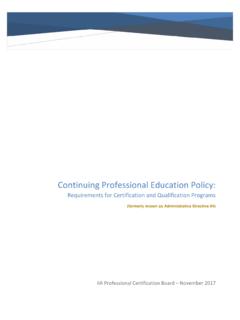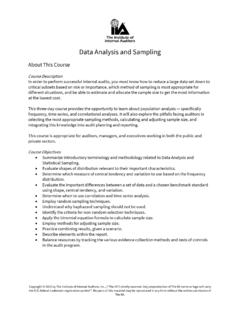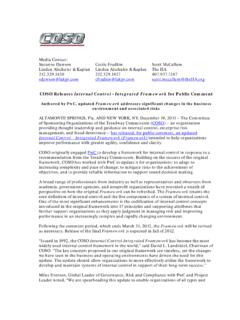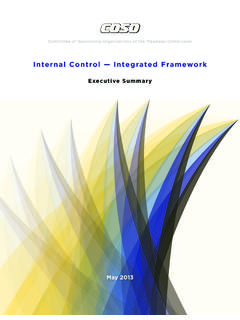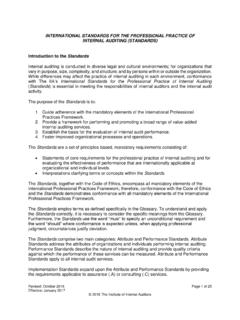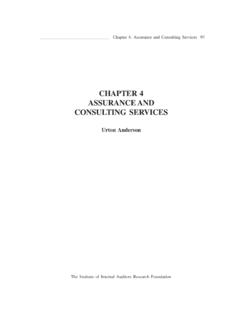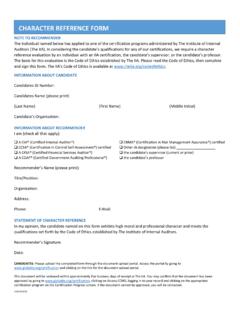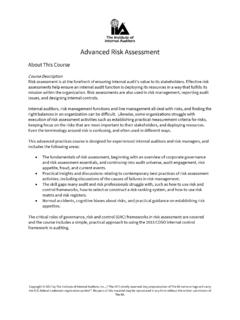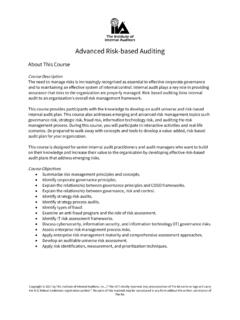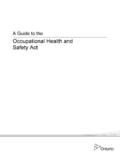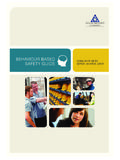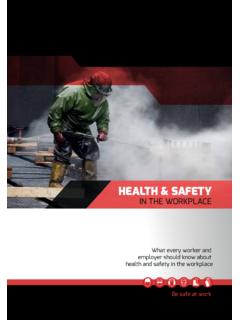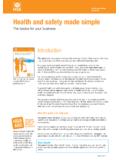Transcription of BEAC CPEA Health & Safety Auditor Examination Study …
1 BEAC CPEA Health & Safety Auditor Examination Study guide Introduction and General Structure of the Examination Introduction This Study guide is intended to assist an applicant in preparing for the Board of Environmental, Health & Safety Auditor Certification's (BEAC) Health & Safety Auditor Examination . Successfully passing the BEAC Health &. Safety exam is one of several criteria that must be met in order to achieve the Certified Professional Environmental Auditor (CPEA) designation in Health & Safety from BEAC. The Study guide consists of four sections: 1. General Structure of the Examination : Gives an overview of the Examination structure, pass/fail criteria, and timing;. 2. Examination Outline: Lists the topics and subject areas covered by the Examination ;. 3. Sample Questions and Answers: Provides examples similar to actual questions on the Examination . Answers are provided for the example multiple-choice questions, but not for the example essay questions.
2 4. Reference List: Lists books and documents that BEAC believes are generally accepted sources, which may be useful to the examinee and from which some of the questions may have been derived. Note: The Study guide does not address test-taking strategies or tactics. If it has been some time since you last sat for an Examination , it might be useful to refresh your memory of the basics. ( , Read questions carefully. Don't agonize too long over a troublesome question; skip it and come back later if time permits. Don't make random guesses, etc.). 1. General Structure of the Examination The BEAC Health & Safety Auditor Examination consists of three parts: Part I. Basic Principles of Auditing (131 multiple-choice questions; answer all). Part II. Health & Safety Requirements (152 multiple-choice questions; answer all). Part III. Understanding Health & Safety Standards (four short-answer questions and four essay questions.)
3 Answer all). The Examination is administered in three segments, with two hours provided to complete each part of the exam. There is a break between each section of the Examination . The exam grading process is as follows: Part I and Part II multiple-choice questions are graded using a template. Responses to essay questions are copied and sent out to two members of the Examination Committee who grade independently, (using a matrix) which assigns points. At the BEAC office, the two scores are averaged together and stand as the score on the essay portion of the exam. Should the two grades differ by more than 20%, the essay is sent to a third grader, and the two closest scores are used. Scores for all three parts are averaged together, and the overall Total Score determines whether or not the applicant has passed or failed ( , not all individual parts must be passed). If the applicant fails the exam but passes any of the individual parts, they can obtain an exemption from taking those parts when they re-take the exam.
4 2. Examination Outline Part I. Basic Principles of Auditing The questions in this part are quite generic; they will apply in essentially the same way to environmental compliance or Health & Safety compliance auditing as they do to management system auditing. The questions will be multiple-choice choose the ONE best answer from four choices. Subjects covered in Part I include the following: Ethics and Standards of Conduct for auditors This category relates to the candidate's understanding, judgment, and perception of how an Auditor should behave and react to ethical situations that can occur in the audit process. This may include some questions concerning BEAC and The Institute of Internal auditors (IIA) Standards for auditing. Test questions focus on topics such as: Conflict of Interest. Independence of auditors . Due Professional Care. Material Facts and Disclosure. Auditor Proficiency. Audit Program Design This category includes issues related to the design, structure, and key planning elements of audit programs.
5 Test questions focus on topics such as: Senior Management Commitment. Scope of Audit Programs. Audit Tools. Site Selection/Frequency of Audits. Quality Assurance Mechanisms. Auditor Staffing/Training. Audit Activities This category relates to activities associated with actually conducting a specific audit. Test questions focus on topics such as: Pre-audit Activities ( , gathering background information; contacting the facility; coordinating the audit team). On-site Activities ( , opening meeting and facility tour; assessing and evaluating compliance programs and procedures; gathering information: interviewing, reviewing documents and records, sampling, and conducting inspections; handling sensitive situations; evaluating audit evidence and writing findings;. closing meeting). Post-audit Activities ( , report preparation; legal protection/confidentiality of results; corrective action planning and tracking).
6 Part II. Health & Safety Requirements There will be 152 multiple-choice questions in this part; they will be generally more complex than those in Part I. Many questions will present a, b, c, d, etc., alternative answers. Some of the questions in this part relate to general Health & Safety concepts. However, many questions will be quite specific and require recognition or recall of the detailed requirements of particular Occupational Health and Safety Administration (OSHA) standards and/or applicable regulatory requirements. The applicant will not have to know them chapter and verse but will be required to know content. This section relates to the candidate's understanding, judgment, and perception of topics such as: Internal Controls This category relates to an Auditor 's need to understand the procedures that exist at the audited facility to ensure compliance with applicable regulations. Test questions could focus on topics such as: Identification of Applicable Compliance Areas.
7 Responsibility/Accountability for Compliance Task/Functions. Training/Qualifications of Facility Staff. Availability of Compliance Procedures. Self-assessment Mechanisms for Compliance. Legislative/Regulatory Applicability This category relates to an Auditor 's need to understand what Health and Safety laws and regulations apply to particular activities or operations at audited facilities. Test questions could focus on topics such as: Major Regulatory Focus of General and Construction Standards and Recordkeeping. Federal OSHA/State Jurisdiction/Enforcement of Laws. Regulatory Process (interim, draft, final). Ability to Determine Applicability of Occupation Safety and Health Laws/Regulations to Typical Worker Activities and Workplace Environments at the Audited Facility. Relationship of OSHA standards to: o American National Standards Institute (ANSI) standards o National Electric Code (NEC). o National Fire Protection Agency (NFPA).
8 O American Society for Testing and Materials (ASTM). o American Society of Mechanical Engineers (ASME). Occupational Safety and Health Impacts of Various Worker Activities, Workplace Environments, and Related Exposure Reducing Practices and Technologies This category relates to an Auditor 's ability to evaluate what occupational Safety and Health impacts and compliance issues result from typical worker activities and workpplace environments; and understanding the generic engineering, administrative, and personal protective equipment and technologies to control potential impacts. Test questions could focus on topics such as: Typical Health and Safety Exposures Generated by Various Workplace Activities and Environments. Exposure Thresholds that Trigger Compliance Requirements. General Concepts of Operation of Engineering, Administrative, and Personal Protective EquipmentPractices and Technologies. Typical Compliance-related Requirements Associated with Engineering, Administrative, and Personal Protective Equipment Practices and Technologies.
9 Activity/Environment-specific Regulatory Knowledge (29 CFR 1910 and 1926). This category relates to an Auditor 's knowledge of key regulatory requirements that are typically evaluated during an audit. Test questions could focus on topics such as: 1910 - Occupational Safety and Health Standards (General Industry). Asbestos Blood-borne Pathogens Compressed Gas and Compressed Air Equipment Confined Space Contractor Safety Cylinder Storage Electrical Emergency Response Environmental Monitoring Fall Protection Fire Protection Flammable Liquid/Gas Storage General Environmental Controls Hand and Portable Powered Tools and Other Hand-held Equipment Hazard Communication Hazardous Materials Hazardous Waste Operations and Emergency Response (HAZWOPER). Hearing Conservation Hoisting and Cranes Incident Investigation Laboratory Safety Lead Life Safety Lock Out/Tag Out Machinery and Machine Guarding Materials Handling and Storage Medical and First Aid Motor Vehicle Safety Noise Monitoring Occupational Health and Safety Environmental Controls Personal Protective Equipment Powered Platforms, Manlifts, and Vehicle-mounted Work Platforms Pressure Vessels Process Safety Management Recordkeeping Respiratory Protection Special Industries Threshold Limit Values (TLVs).
10 Ventilation Walking -/Working Surfaces Welding, Cutting, and Brazing 1926 - Safety and Health Regulations for Construction (Construction Standards). Blasting and the Use of Explosives Concrete and Masonry Construction Cranes, Derricks, Hoists, Elevators, and Conveyors Demolition Electrical Excavations Fall Protection Materials Handling, Storage, Use, and Disposal Motor Vehicles, Mechanized Equipment, and Marine Operations Occupational Health and Environmental Controls Personal Protective and Life-saving Equipment Power Transmission and Distribution Rollover Protective Structures; Overhead Protection Scaffolds Signs, Signals, and Barricades Stairways and Ladders Steel Erection Tools - Hand and Power Toxic and Hazardous Substances Underground Construction, Caissons, Cofferdams, and Compressed Air Welding and Cutting It is not expected that examinees will be familiar with the specific details of all of the standards/codes/regulations or sections thereof listed above.
